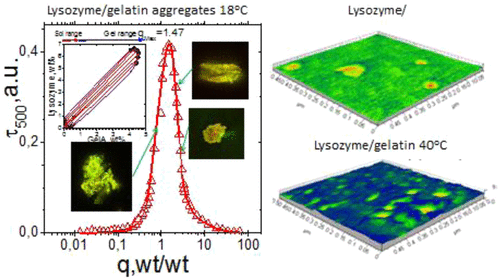Our official English website, www.x-mol.net, welcomes your
feedback! (Note: you will need to create a separate account there.)
Effect of the Helix–Coil Transition in Bovine Skin Gelatin on Its Associative Phase Separation with Lysozyme
Langmuir ( IF 3.7 ) Pub Date : 2017-11-13 00:00:00 , DOI: 10.1021/acs.langmuir.7b01477 Yurij A. Antonov 1 , Irina Zhuravleva 1 , Alexander Volodine 2 , Paula Moldenaers 3 , Ruth Cardinaels 3, 4
Langmuir ( IF 3.7 ) Pub Date : 2017-11-13 00:00:00 , DOI: 10.1021/acs.langmuir.7b01477 Yurij A. Antonov 1 , Irina Zhuravleva 1 , Alexander Volodine 2 , Paula Moldenaers 3 , Ruth Cardinaels 3, 4
Affiliation

|
It is known that the formation of electrostatic polyelectrolyte complexes can induce conformational changes in the interacting macromolecules. However, the opposite effect, namely, that of the helix–coil transition of one of the interacting polyelectrolytes on its associative phase separation with another polyelectrolyte and the possible phase transitions in such systems, has not been determined. Atomic force and confocal laser scanning microscopy, phase analysis, dynamic and electrophoretic light scattering, turbidimetry, absorption, and fluorescence measurements as well as differential scanning calorimetry and rheology were used to study the effect of the helix–coil transition in bovine skin gelatin (Gel) on its associative phase separation with hen egg white lysozyme (Lys) at different temperatures (18–40 °C) and various Lys/Gel weight ratios (0.01–100) at low ionic strength (0.01) and pH 7.0. The effects of the main variables on the phase state, the phase diagram, and the main complexation and binding parameters as well as the temperature and enthalpy of the helix–coil transition of Gel within the complexes were investigated. Associative phase separation is observed only for the system with Gel in the helix state. Effective charge and structure and the solution and rheological behavior of the formed complexes proved to be dependent on the [An–]/[Cat+] charge ratio. The localization of Lys within the complex particles has irregular character without the formation of a single center of binding. The binding of Lys with Gel does not lead to the disruption of its tertiary structure or to an appreciable change in the thermodynamic parameters of the thermal transitions of Lys. Gel in the coil state interacts only weakly with Lys, forming water-soluble complex associates. It is suggested that the Voorn–Overbeek model could potentially describe the stronger binding and phase separation in the case of Gel in the helix state.
中文翻译:

牛皮肤明胶中螺旋-螺旋转变对溶菌酶缔合相分离的影响
已知静电聚电解质复合物的形成可以在相互作用的大分子中诱导构象变化。但是,还没有确定相反的作用,即相互作用的一种聚电解质在与另一种聚电解质缔合相分离时的螺旋-螺旋转变及其在此类体系中可能发生的相转变的影响。原子力和共聚焦激光扫描显微镜,相分析,动态和电泳光散射,比浊法,吸收,和荧光测量以及差示扫描量热法和流变学被用于研究在不同温度下牛皮肤明胶(Gel)与蛋清溶菌酶(Lys)的螺旋-螺旋转变对缔合相分离的影响(18-40 °C)和低离子强度(0.01)和pH 7.0时各种Lys / Gel重量比(0.01–100)。研究了主要变量对相态,相图,主要络合和结合参数以及配合物中凝胶的螺旋-螺旋转变的温度和焓的影响。仅对于凝胶处于螺旋状态的系统,观察到缔合相分离。有效电荷和结构以及形成的配合物的溶液和流变行为证明取决于[An 低离子强度(0.01)和pH 7.0时为01–100)。研究了主要变量对相态,相图,主要络合和结合参数以及配合物中凝胶的螺旋-螺旋转变的温度和焓的影响。仅对于凝胶处于螺旋状态的系统,观察到缔合相分离。有效电荷和结构以及形成的配合物的溶液和流变行为证明取决于[An 低离子强度(0.01)和pH 7.0时为01–100)。研究了主要变量对相态,相图,主要络合和结合参数以及配合物中凝胶的螺旋-螺旋转变的温度和焓的影响。仅对于凝胶处于螺旋状态的系统,观察到缔合相分离。有效电荷和结构以及形成的配合物的溶液和流变行为证明取决于[An– ] / [Cat + ]电荷比。Lys在复合颗粒中的定位具有不规则的特征,而没有形成单个结合中心。Lys与凝胶的结合不会导致其三级结构的破坏,也不会导致Lys热转变的热力学参数发生明显变化。盘绕状态的凝胶仅与Lys弱相互作用,形成水溶性复合物缔合体。建议Voorn-Overbeek模型可以潜在地描述在螺旋状态的Gel情况下更强的结合和相分离。
更新日期:2017-11-13
中文翻译:

牛皮肤明胶中螺旋-螺旋转变对溶菌酶缔合相分离的影响
已知静电聚电解质复合物的形成可以在相互作用的大分子中诱导构象变化。但是,还没有确定相反的作用,即相互作用的一种聚电解质在与另一种聚电解质缔合相分离时的螺旋-螺旋转变及其在此类体系中可能发生的相转变的影响。原子力和共聚焦激光扫描显微镜,相分析,动态和电泳光散射,比浊法,吸收,和荧光测量以及差示扫描量热法和流变学被用于研究在不同温度下牛皮肤明胶(Gel)与蛋清溶菌酶(Lys)的螺旋-螺旋转变对缔合相分离的影响(18-40 °C)和低离子强度(0.01)和pH 7.0时各种Lys / Gel重量比(0.01–100)。研究了主要变量对相态,相图,主要络合和结合参数以及配合物中凝胶的螺旋-螺旋转变的温度和焓的影响。仅对于凝胶处于螺旋状态的系统,观察到缔合相分离。有效电荷和结构以及形成的配合物的溶液和流变行为证明取决于[An 低离子强度(0.01)和pH 7.0时为01–100)。研究了主要变量对相态,相图,主要络合和结合参数以及配合物中凝胶的螺旋-螺旋转变的温度和焓的影响。仅对于凝胶处于螺旋状态的系统,观察到缔合相分离。有效电荷和结构以及形成的配合物的溶液和流变行为证明取决于[An 低离子强度(0.01)和pH 7.0时为01–100)。研究了主要变量对相态,相图,主要络合和结合参数以及配合物中凝胶的螺旋-螺旋转变的温度和焓的影响。仅对于凝胶处于螺旋状态的系统,观察到缔合相分离。有效电荷和结构以及形成的配合物的溶液和流变行为证明取决于[An– ] / [Cat + ]电荷比。Lys在复合颗粒中的定位具有不规则的特征,而没有形成单个结合中心。Lys与凝胶的结合不会导致其三级结构的破坏,也不会导致Lys热转变的热力学参数发生明显变化。盘绕状态的凝胶仅与Lys弱相互作用,形成水溶性复合物缔合体。建议Voorn-Overbeek模型可以潜在地描述在螺旋状态的Gel情况下更强的结合和相分离。











































 京公网安备 11010802027423号
京公网安备 11010802027423号